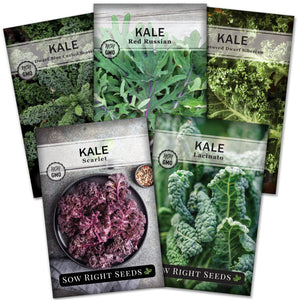Topics
Sunshine 101: Making Sense of Full Sun for Flowers, Herbs, and Vegetables
You pick up a packet of seeds, excited to start planting. Quickly checking the growing specifications, you notice “light requirements” along with planting depth and other information. What does “Full Sun” really mean? How many hours are we talking about?
If you’ve ever brushed off this requirement or been confused about what it means, now is the time to learn. It’s essential to understand the differences between full sun, part sun, part shade, and shade. We’ll explain these terms and why light requirements matter for growing healthy herbs, flowers, and vegetables.

Light Requirements for Outdoor Plants Explained
When it comes to sunlight, not all plants have the same requirements. Some plants thrive in shade, while others need full sun to reach their full potential.
Knowing the difference between full sun, part sun, part shade, and shade will help you be ready for planting seeds. Growing flowers, herbs, and vegetables in the right location will give you the best results.

Why Sunlight Matters
It’s all about photosynthesis. In simple terms, plants harness the energy of sunlight through the process of photosynthesis. The plant uses this energy to grow and produce beautiful flowers and delicious fruits and vegetables.
Without enough sun, your plants won’t have the energy they need to grow to their full potential. No blooms and stunted growth can be signs of not enough sunlight.
To ensure the healthy growth and development of plants, it is essential to understand their specific sun requirements. Since sunlight plays a crucial role in photosynthesis, you’ll want to give your plants the recommended amount of light they need.

Track Your Garden's Sunlight
When planning your garden and choosing which seeds to buy, first determine the amount of daily sunlight your garden receives.
Keeping a garden journal is an excellent way for gardeners to track their daily sun exposure. You can write down when your garden spot first gets light in the morning. Then, check on it every hour or so throughout the day. Be sure to note if it gets direct light or dappled shade.
It is worthwhile to note whether a location receives morning or afternoon sun. For some plants, the intense heat of the afternoon sun is too brutal, whereas the morning light is much more gentle.
It’s also important to note seasonal changes. You may be excited to start your garden and think you’ve found the perfect sunny spot in early spring. Only to realize in late June that the leafy trees now cast too much shade on that spot. Also, your house and other buildings will cast longer shadows in the fall than in the middle of summer. So take time to note the seasonal changes.
Remember, those sunny spots that become shady in the summer can be perfect for early crops and spring bulbs.

Defining Sun Requirements for Plants
Typically, you will see full sun, part sun, part shade, and full shade on seed packets. We’ll explain each of these light requirements so you know what you can plant in your location.

Full Sun
Full sun is defined as more than 6 hours of direct sunlight. Seed packets and plant labels that say “Full Sun” are plants that need at least 6 hours of direct sun daily. And that’s a minimum. Usually, flowers and vegetables with this light requirement will do even better with 8 to 10 hours of direct sun. Plants that don’t get enough sunlight can be straggly, produce few, if any, flowers, and have less color.
Best full sun plants
So what flowers and vegetables can you grow in full sun? Just about everything. All those delicious summer vegetables and most flowers are going to be in this category.
On our seed packets, you’ll see “full sun” listed under light requirements.
Some of our favorite full sun flowers are zinnias, dahlia, black-eyed Susan.
Herbs like lavender and rosemary are perfect for growing in full sun.
Vegetable garden favorites for full sun are watermelons, tomatoes, peppers, and zucchini.

Part Sun
Part sun is defined as 3 to 6 hours of direct sunlight. These plants will do just fine with less direct sunlight. Part sun plants will enjoy a good dose of morning sun. Another round of direct light in the evening can add to the total hours of light. The amount of light a plant receives doesn’t have to be continuous.
Partial sun plants
Broccoli is one of those vegetables that can grow in full sun, but it is temperature sensitive. So, growing broccoli with morning sun and shade in the afternoon can result in a better harvest.
Celery also prefers cooler temperatures and can be grown in partial sun.

Part Shade
Part shade is defined as 3 to 6 hours of direct sunlight. Although it is technically the same length of time as part sun, it’s referring to shade. This means that part shade plants prefer some shade during the most intense light of mid-day.
Partial shade plants
Flowers that thrive in part shade are those that don’t tolerate the mid-day heat. These include English daisy, impatiens, and columbine.
Some herbs to grow in part shade are catnip, mint, parsley, and cilantro.
Many leafy greens will grow well in part shade. Lettuce, arugula, spinach, bok choy, and kale will tolerate the heat better when grown in partial shade.

Shade
Full shade is 3 hours or less of direct sunlight. Although this is called “full shade,” plants still need some direct sunlight. A spot where the sun shines on them in the morning or evening is usually the best for shade plants.
Full shade plants
Plants that can thrive in full shade are few. Plants need light for photosynthesis. Plants that can live in the shade are generally ones that don’t produce flowers. Think of ferns growing in a forest. They thrive where they are, but put them out in a sunny spot, and they shrivel up and die.
Areas that never receive direct sunlight won’t be able to support life. This is the area where you can use decorative rocks or mulch.
Using Sunlight Requirements for Garden Planning
Now that you know the definition of light requirement terms, you can plan your garden.
The spot where your garden gets full sun is perfect for growing your tomatoes, peppers, and sun-loving plants.
Plant those peas, broccoli, celery, and other heat-sensitive crops where they have part sun.
Lengthen the growing season of your leafy greens by planting them in part shade.

Morning Sun vs Afternoon Sun
The intensity of the sunlight is different throughout the day. If you want to avoid the most intense sun rays, stay inside between the hours of 10 and 2. Your plants can’t walk inside during this time, so plan accordingly. Some plants thrive in the hot, mid-day sun, while others appreciate shade. Plants such as tomatoes, peppers, and corn love this intense sunlight and turn all that light into delicious food.
But coleus, lettuce, and other plants will prefer some shade during the hours of intense sunlight.
Can full sun plants grow in the shade?
While plants that require full sun will still grow in shady locations, they won’t reach their full potential. Flowers won’t produce blooms, and vegetables won’t develop. Giving full-sun plants at least 6 hours of direct light daily is essential. 8 to 10 hours will provide even better results.
Making Adjustments
Master gardeners know that every garden is different. There are microclimates in every landscape, and you can make adjustments.
The heat in Texas and Arizona makes full sun more intense than in Oregon or Maine. Plants that grow well under full sun in Oregon might need some shade in Arizona.
Even plants that prefer part sun may get too hot and wilt under intense heat. For these plants, tricks such as using mulch to keep the ground cool and watering frequently can help.
These differences are what individual gardeners experiment with. If something doesn’t work in a specific season or location, you can always try another spot or different time of year.
Paying attention to the amount of sunlight is extremely useful for giving your plants the best care.
At Sow Right Seeds, we want you to be successful in growing from seed. Understanding the basic gardening terms will help you determine where and how to plant your seeds. Full sun and partial shade are common light requirements for plants. The first step is to know how many hours of daily sunlight your garden receives. With this information, you will be able to choose plants that will grow well in your location.
Written by Beverly Laudie
Found this information helpful? Share it with a gardening friend!







Leave a comment